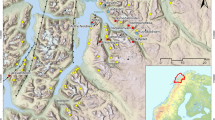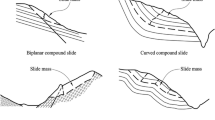Abstract
The Marrakech–Agadir highway crosses mountainous areas of the Western High Atlas of Morocco with a high risk of slope instability. The use of explosives as an excavation method, especially at kilometric point 33 on the Imintanout–Argana section, has triggered major ruptures. The regional geological setting, together with the lithological and structural characteristics of the rock mass, represent the major factors influencing this operation where the degree of disturbance is estimated as 0.82. The studied slope is located along the trajectory of a submeridian fault corridor remobilised because of blasting during excavation works. This slope reveals instabilities associated with tectonic planes (F1 and F2) and/or bedding (S0) and the presence of argillites and siltstones that coincide with bedding. These unconsolidated layers, inclined in the direction of excavation, act as slide planes. Structurally, the Pk33 slope can be subdivided into three zones depending on the displacement type being recorded and may be a fortiori related to the geomechanical properties of the substrate. The rheological characteristics of zones B and C, highly fractured and with low competence, respectively, explain their relatively different displacement patterns from that of zone A. The maximum instantaneous explosive load used for offloading the upper part of the sliding mass has been estimated in order to increase the safety factor for the instable slope.
















Similar content being viewed by others
References
Cojean R (2003) Les processus de déformation et rupture des versants instables. Rôle des structures géologiques, des matériaux et des conditions hydrauliques. Apports et limites de la modélisation dans l’analyse de scénarios d’événements. Dissertation (Habilitation à diriger des recherches), University of Marne la Vallée (France)
Delille F (2012) Recherche d’une prédiction de fragmentation charge par charge pour les tirs à ciel ouvert. Dissertation (PhD thesis), Ecole Nationale Supérieure des Mines de Paris
Dowding CH (1985) Blast vibration, monitoring and control. Prentice Hall, Englewood Cliffs
Duffaud F, Brun L, Plauchut B (1966) Le bassin du Sud-Ouest marocain. In: Reyere D (ed) Bassins sedimentaires du littoral africain. Publication de L’Association Services Géologiques Africains, Paris, pp 5–26
Gaillard C, Panigoni T (2012) Influence du terrain dans la propagation des vibrations. Géotechnique Francophone. JNGG’2012, Journées Nationales de Géotechnique et de Géologie de l’Ingénieur, Bordeaux, 4 au 6 juillet 2012, p 8. http://www.geotech-fr.org/sites/default/files/congres/jngg/JNGG-2012-99.pdf. Accessed 27 July 2015
González-Nicieza C, Álvarez-Fernandez MI, Alvarez-Vigil AE, Arias-Prieto D, López-Gayarre F, Ramos-Lopez FL (2014) Influence of depth and geological structure on the transmission of blast vibrations. Bull Eng Geol Environ 73:1211–1223. doi:10.1007/s10064-014-0595-7
Görgülü K, Arpaz E, Demirci A, Kocaslan A, Dilmac MK, Yüksek AG (2013) Investigation of blast-induced ground vibrations in the Tülü boron open pit mine. Bull Eng Geol Environ 72:555–564. doi:10.1007/s10064-013-0521-4
Hajihassani M, Armaghani DJ, Marto A, Mohamad ET (2015) Ground vibration prediction in quarry blasting through an artificial neural network optimized by imperialist competitive algorithm. Bull Eng Geol Environ 74:873–886. doi:10.1007/s10064-014-0657-x
Hoek E (2007) Practical rock engineering. Hoek’s corner in Rocscience web. https://www.rocscience.com/learning/hoek-s-corner/books. Accessed 27 July 2015
Hoek E, Brown ET (1997) Practical estimates of rock mass strength. Int J Rock Mech Min Sci 34:1165–1186. doi:10.1016/S1365-1609(97)80069-X
Hoek E, Carranza-Torres C, Corkum B (2002) Hoek–Brown failure criterion-2002 edition. Proc NARMS-Tac Conf Tor 1:267–273
Li AJ, Merifield RS, Lyamin AV (2011) Effect of rock mass disturbance on the stability of rock slopes using the Hoek–Brown failure criterion. Comput Geotech 38:546–558
Marinos V, Marinos P, Hoek E (2005) The geological strength index: applications and limitations. Bull Eng Geol Environ 64:55–65. doi:10.1007/s10064-004-0270-5
Medina F (1994) Evolution structurale du Haut Atlas occidental et des régions voisines, dans le cadre de l’ouverture de l’Atlantique Central et de la collision Afrique-Europe. Dissertation (PhD thesis) Mohamed V University, Rabat, Morocco
Nateghi R (2011) Prediction of ground vibration level induced by blasting at different rock units. Int J Rock Mech Min Sci 48:899–908
Rocscience (2005) 2D limit equilibrium analysis software slide 5.0. http://www.rocscience.com. Accessed Mar 2014
Scott A (1999) Effective blast engineering. In: Explo’99, AusIMM, pp 57–63. http://www.ausimm.com.au/publications/epublication.aspx?ID=2938. Accessed Mar 2014
Singh PK, Roy MP, PaswanRanjit K (2014) Controlled blasting for long term stability of pit-walls. Int J Rock Mech Min Sci 70:388–399. doi:10.1016/j.ijrmms.2014.05.006
Tatard L (2010) statistical analysis of triggered landslides: implication for earthquake and weather controls. Dissertation (PhD thesis), Joseph-Fourier University. Grenoble I, France
Wyllie DC, Mah C (2004) Rock slope engineering. CRC Press, Taylor and Francis Group, New York
Acknowledgments
This research was performed in a program of collaboration between Granada University in Spain and Hassan II University in Morocco. This collaboration was supported by a grant for exchange and cooperation between Europe and the Maghreb in the Erasmus Mundus–Al Idrisi project. This work has also been possible thanks to the Moroccan Public Laboratory of Testing and Studies (LPEE).
Author information
Authors and Affiliations
Corresponding author
Rights and permissions
About this article
Cite this article
Benchelha, T., Remmal, T., El Hamdouni, R. et al. Combined effects of blasting and geological structure on rock mass stability—a case study from the Marrakech–Agadir highway, Morocco. Bull Eng Geol Environ 76, 815–828 (2017). https://doi.org/10.1007/s10064-016-0867-5
Received:
Accepted:
Published:
Issue Date:
DOI: https://doi.org/10.1007/s10064-016-0867-5




